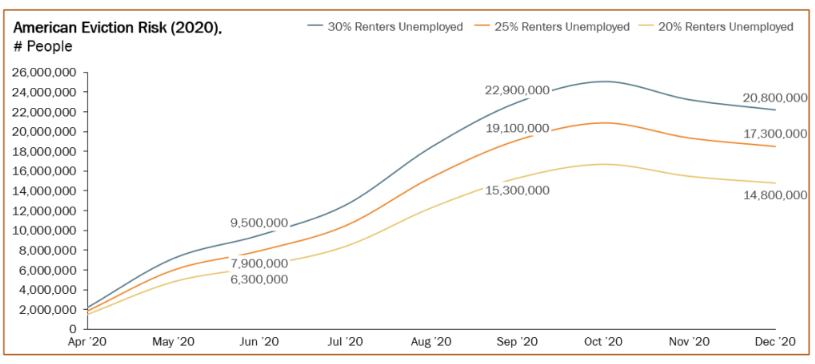Does Eviction Protection Still Apply to You?

ByAnna Baluch
UpdatedJun 26, 2025
- COVID eviction protection has been extended to June 30, 2022.
- However, it does not apply to everyone.
- State and local governments may have other eviction protection in place.
Table of Contents
If you’re a tenant, the coronavirus pandemic may have made it difficult for you to pay rent, but assistance became available when the CARES Act temporarily banned evictions and late fees. The Act also required landlords give a 30-day notice before evicting a tenant.
Unfortunately, these protections came to an end on July 25th when the CARES act expired, leaving millions of American families at risk of eviction by September of this year. The Aspen Institute shows just how high that risk could be:

So is there any type of eviction protection still available to the millions of families who rent or lease their homes? Let’s take a closer look at current protections for tenants.
If your property was covered under CARES:
Landlords can’t file until after August 23rd
Now that the CARES Act has expired, you may be charged late fees and possibly asked to leave the apartment, condo, or house if you can’t pay your rent. However due to the 30-day notice requirement, a landlord won’t be able to file eviction until August 24th.
Keep in mind that this only applies if you live in a property that’s received money from or financed by a federally-backed mortgage, like one that’s subsidized by Fannie Mae, Freddie Mac, or the U.S. Department of Housing & Urban Development. To determine whether your property is covered, check out this database by the National Low Income Housing Coalition.
If your property isn’t covered under CARES:
Look for state or local moratoriums
If your property is not covered, you may want to do some research and find out if there are any state or local moratoriums that can help. Go to Google and search “emergency rental assistance” or “eviction protection” and the name of your city, county, or state. You can also call the housing authority organization in your state. For example, you can get advice from housing experts in Texas by calling (888) 995-4673.
Some cities still have protections in place. In San Francisco, Mayor London Breed issued eviction protection that applies to all residential units and will be in effect until August 31st. The San Francisco edict states that you cannot be evicted during the coronavirus outbreak. In New York, Governor Andrew Cuomo has extended eviction protection for residential tenants until August 20th. In New York, those who are facing financial hardship cannot be evicted for not paying rent.
What to do if you can’t pay rent
Whether or not eviction protection under the CARES Act or a state or local moratorium still applies to you, there are a number of strategies that could be of help if you can’t pay rent.
Negotiate with your landlord
Don’t be afraid to approach your landlord, explain your situation, and try to negotiate a solution. Landlords are often in a difficult spot as well, and may allow you to defer your payment or make a partial payment, especially if you’ve been a good tenant. If you do come to an agreement, put it in writing and sign it to avoid any confusion or conflict down the road.
Trade rent for labor or services
Your landlord may need some help maintaining the property you live in or another property they own. Offer to mow the lawn, care for their garden, perform a minor repair, or perform similar services in exchange for a modification to your rent agreement. Again, put any changes to your rental agreement in writing, and have both parties sign the document.
Move money around
If you’ve received forbearance on a student loan, car loan, cell phone bill, insurance plan, or anything else, consider moving the money you would’ve used on it to rent.
In the event you haven’t received forbearance, contact your lenders, creditors, and service providers and ask for a discount or fee waiver. They may accommodate your request and free up some of your funds so that you can pay your rent.
Turn to a national or local organization
Fortunately, there are several national and local organizations that may be able to provide you with rent relief until you get back on your feet. You may apply for one-time rental assistance, collect ongoing financial aid, or take advantage of public housing or other resources. The Salvation Army, USDA Rural Development Program, and Catholic Charities USA are a few examples of organizations you may want to contact.
Prioritize rent over debt
When you have limited cash on hand, housing should be at the top of your priority list. Even if you’re lucky enough to be covered by eviction protection or a moratorium, you’re not off the hook forever. You may eventually end up having to pay all your missed payments at once.
If you have debt payments to make, it’s okay to pay just the minimums for now and use the money to cover your rent payments. Try to keep up with your payments though, to prevent late fees and additional debt.
Need assistance with your debt? FDR can help.
If you’re struggling with your rent and finances and hope to move toward a stronger financial position in the future, it might be time to take a bigger step. If you can’t afford to deal with your debt anymore, Freedom Debt Relief is here to help you understand your options, including our debt relief program. Our Certified Debt Consultants can help you find a solution that could put you on the path to a better financial future.
Learn More
Reducing Expenses During a Sudden Financial Hardship (Freedom Debt Relief)
How to Ask Creditors for Loan and Credit Card Forbearance (Freedom Debt Relief)
Should You Borrow Money from Friends and Family in Hard Times (Freedom Debt Relief)
Is it OK Not to Pay Rent During the COVID-19 Pandemic? (Marketplace)
A look into the world of debt relief seekers
We looked at a sample of data from Freedom Debt Relief of people seeking the best debt relief company for them during May 2025. This data highlights the wide range of individuals turning to debt relief.
FICO scores and enrolled debt
Curious about the credit scores of those in debt relief? In May 2025, the average FICO score for people enrolling in a debt settlement program was 593, with an average enrolled debt of $26,333. For different age groups, the FICO scores varied. For instance, those aged 51-65 had an average FICO score of 589 and an enrolled debt of $28,538. The 18-25 age group had an average FICO score of 548 and an enrolled debt of $15,062. No matter your age or debt level, it's reassuring to know you're not alone. Taking the step to seek help can lead you towards a brighter financial future.
Student loan debt – average debt by selected states.
According to the 2023 Federal Reserve Survey of Consumer Finances (SCF) the average student debt for those with a balance was $46,980. The percentage of families with student debt was 22%. (Note: It used 2022 data).
Student loan debt among those seeking debt relief is prevalent. In May 2025, 27% of the debt relief seekers had student debt. The average student debt balance (for those with student debt) was $48,703.
Here is a quick look at the top five states by average student debt balance.
| State | Percent with student loans | Average Balance for those with student loans | Average monthly payment |
|---|---|---|---|
| District of Columbia | 34 | $71,987 | $203 |
| Georgia | 29 | $59,907 | $183 |
| Mississippi | 28 | $55,347 | $145 |
| Alaska | 22 | $54,555 | $104 |
| Maryland | 31 | $54,495 | $142 |
The statistics are based on all debt relief seekers with a student loan balance over $0.
Student debt is an important part of many households' financial picture. When you examine your finances, consider your total debt and your monthly payments.
Regain Financial Freedom
Seeking debt relief can be the first step toward financial freedom. Are you struggling with debt? Explore options for debt relief to regain control of your finances. It doesn't matter how old you are or what your FICO score or credit utilization is. Take the first step towards a brighter financial future today.
Show source
Author Information

Written by
Anna Baluch
Anna Baluch is a freelance writer who enjoys writing about all personal finance topics. She’s particularly interested in mortgages, retirement, insurance, and investing.

